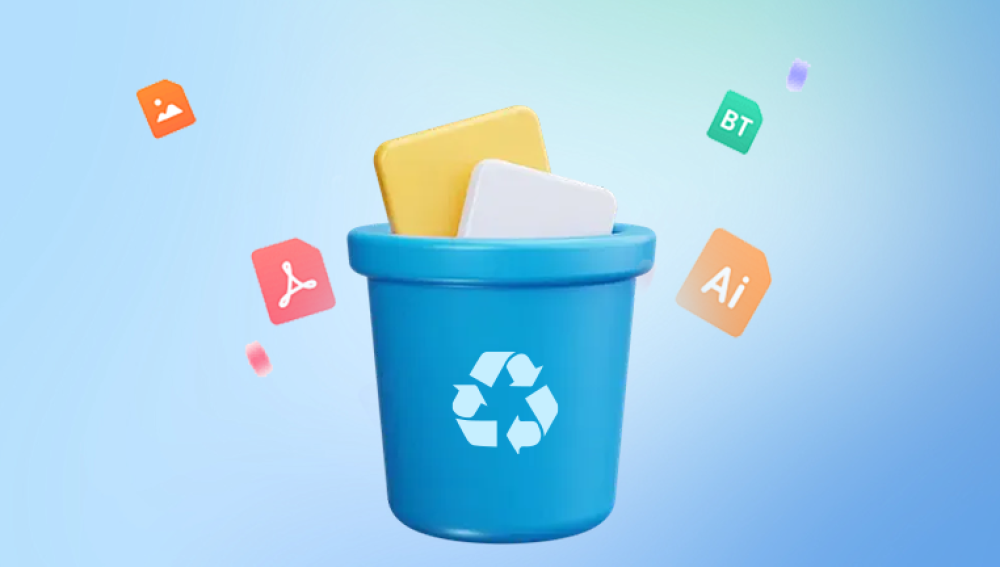1. How File Deletion Works
Before diving into recovery methods, it’s helpful to understand what actually happens when a file is deleted.
Soft Delete vs. Permanent Delete
Soft Delete: Files moved to the Recycle Bin (Windows) or Trash (Mac) are not truly deleted and can be easily restored.
Permanent Delete: Files deleted using Shift + Delete or emptied from the Recycle Bin are marked as “free space” by the system, making recovery possible but not guaranteed.
Timeliness Is Key
The longer you wait, the higher the chance that new data will overwrite the deleted file, making recovery impossible.

2. Method 1: Check the Recycle Bin (Windows) or Trash (Mac)
This is the simplest and most common way to retrieve a deleted Word document.
Windows:
Open the Recycle Bin by double-clicking the icon on the desktop.
Look for your deleted Word file.
Right-click on it and choose Restore.
macOS:
Open the Trash from the Dock.
Search or browse for your deleted Word file.
Right-click and choose Put Back to restore it to its original location.
3. Method 2: Recover from AutoRecover and AutoSave
Microsoft Word includes built-in features like AutoRecover and AutoSave to protect your data in the event of accidental loss.
AutoRecover:
AutoRecover saves interim versions of your Word document at regular intervals.
To check AutoRecover files:
Open Word.
Click File > Info > Manage Document.
Choose Recover Unsaved Documents.
Look for your file in the window that opens. If found, open and save it immediately.
AutoSave:
For Office 365 users working in OneDrive or SharePoint, AutoSave may automatically save your work in the cloud every few seconds.
If you deleted a file, go to OneDrive > Recycle Bin and restore it from there.
4. Method 3: Recover Unsaved Word Documents
Even if you didn’t save your file before closing Word, there’s a chance you can still retrieve it.
Steps:
Open Word.
Go to File > Info > Manage Document.
Click Recover Unsaved Documents.
Check for files with the .asd extension.
Select the file you need, then save it with a new name.
You can also manually check the AutoRecover folder:
Windows: C:\Users\[YourName]\AppData\Local\Microsoft\Office\UnsavedFiles
Mac: /Users/[YourName]/Library/Application Support/Microsoft/Office/OfficeVersionNumber/Office AutoRecovery
5. Method 4: Restore from File History or Previous Versions
If you’re using Windows Backup or macOS Time Machine, you may be able to restore an older version of the file.
Windows File History:
Navigate to the folder where the Word file was stored.
Right-click and choose Restore previous versions.
Browse through the available versions and click Restore.
macOS Time Machine:
Connect your Time Machine backup drive.
Open the folder where the Word file was located.
Launch Time Machine and browse for earlier versions of the folder or file.
Click Restore.
6. Method 5: Retrieve from OneDrive or Other Cloud Services
If you use OneDrive, Google Drive, Dropbox, or iCloud, your deleted file might be in the cloud’s recycle bin.
OneDrive:
Log in to your OneDrive account via browser.
Click Recycle Bin.
Locate the deleted Word file.
Select it and click Restore.
Google Drive:
Go to drive.google.com.
Click Trash on the left.
Find your file and right-click > Restore.
Dropbox:
Log in to Dropbox.
Click on Deleted files in the left pane.
Locate your Word file and restore it.
7. Method 6: Use Microsoft Word’s Recent Files Panel
If you didn’t formally save the file but opened it recently, Word might list it under Recent Files.
Steps:
Open Word.
Click File > Open > Recent.
Look for your document. If it's available, open and save it immediately.
This method won’t work if the file was permanently deleted or if it has been too long since the last access.
8. Method 7: Use a Data Recovery Tool
Drecov Data Recovery
To retrieve your Excel file, simply download and install Drecov Data Recovery. Launch the program and select the drive where the file was originally saved. After running a quick or deep scan, the software will present a list of recoverable files. You can filter by file type to locate your spreadsheet quickly, preview it to confirm it’s the correct file, and then restore it with a single click.
Drecov Data Recovery’s intuitive interface and robust recovery engine make it ideal for beginners and professionals alike. If you're dealing with the loss of a vital Excel document, this tool offers a reliable and efficient path to full recovery—saving your time, data, and peace of mind.
9. Preventive Tips to Avoid Future File Loss
Avoiding data loss in the future is just as important as recovering your current file. Here are some tips to protect your work going forward.
A. Enable AutoSave and AutoRecover
Go to File > Options > Save and ensure the following:
AutoSave interval: every 5 minutes or less.
Keep AutoRecovered versions if I close without saving: enabled.
B. Use Cloud Storage
Store files in OneDrive, Google Drive, or Dropbox to take advantage of cloud backups and version history.
C. Regular Backups
Set up File History on Windows or Time Machine on macOS to automate local backups.
D. Version Control
Use Save As to create versions (e.g., Report_v1.docx, Report_v2.docx). This gives you a fallback if something goes wrong.
E. Use Reliable Recovery Tools
Install a trusted recovery tool like Drecov Data Recovery ahead of time, so you’re prepared in case of accidental deletion.
Losing a Word document can be frustrating, but all hope is not lost. Depending on the circumstances, recovering a deleted Word file is very possible especially if you act quickly. Whether it’s checking the Recycle Bin, accessing AutoRecover, restoring previous versions, or using a recovery tool like Drecov Data Recovery, multiple solutions are at your disposal.




